As recovery from the pandemic looms on the horizon, urbanists are exploring new ways to regenerate cities. Beyond Covid lies the opportunity to rebuild the civic realm in innovative ways around infrastructure, transportation, housing, health care, and public space—and in the process, seriously address equity, access, and sustainability.
Such ambitious undertakings can be costly. But there are lessons about how best to use resources to build thriving, diverse cities. And lessons about how not to.
Exhibit A in un-civic design is the largest private real-estate development in the history of the United States: the 28-acre, $25 billion Hudson Yards project on the far west side of Manhattan. When the first half of the mixed-use complex officially opened in March 2019, with a party debuting its shiny seven-story shopping mall, it was clear that the project was designed to be an exclusive haven, isolated from the rest of the city and a widely diverse public.
Hudson Yards sits on a deck constructed over active railyards near the Hudson River. The Related Companies (in partnership with Oxford Properties) won the right to develop the newly minted area, touting it as the largest public-private partnership in the city since Rockefeller Center. Yet that earlier complex is knit into the urban fabric, while this superblock was planned without extending all the adjacent city streets through it. Its half dozen gleaming towers, for high-end offices and luxury apartments—designed by KPF, SOM, DS+R, and Foster + Partners—could be at home in any global metropolis far from New York (one new resident calls the place “Little Dubai”). Glass-and-steel facades front the main thoroughfare, 10th Avenue; entry to the complex from there is only possible via an office building or the mall. There’s not an attempt at even faux urbanity to break that wall with friendly shops at street level.
As part of the agreement with the city, half of the 12 acres in the first phase are designated public space. But much of that is essentially circulation, and all, except for elevated planting beds, is hardscape. There’s little seating, mostly along the masonry planters. And the so-called “Public Square” at the center is hardly anyone’s idea of an open civic plaza, overwhelmed as it is by the Vessel, the gigantic 150-foot-high tourist attraction, with its 154 zigzagging climbable staircases. Designed by Thomas Heatherwick, the $250 million coppertone folly is a monument to Related’s chairman Stephen Ross, who personally oversaw its design and told The New Yorker that he wanted something that was really big.
Hudson Yards is privately controlled space (except for the SHED, the nonprofit cultural center that sits on a patch of city-owned land)—with its own rules, security, and little transparency. It was planned, too, with the latest smart technology, which can regulate its many sustainable features and gather all kinds of data, though few details about the data have been divulged.
While proponents of Hudson Yards cite its value to the city in investment, jobs, and future tax revenues (estimated eventually to be $500 million a year, according to Related, though the developers received $6 billion in tax breaks—you do the math), the few amenities of greatest value to ordinary citizens will be far in the future. Early last month, The New York Times reported that Hudson Yards has Covid-related economic woes, like many businesses. The anchor retail tenant, Neiman Marcus, went bankrupt and shut (its vacant space will be converted to yet more offices). The glittering mall and other buildings are quiet. And the Vessel closed indefinitely in January, for tragic reasons: the third suicide by jumping.
Now the timetable for the final phase of Hudson Yards, originally meant to finish in 2024, “appears on indefinite hold,” according to the Times. That plan calls for eight more towers—by Frank Gehry, Santiago Calatrava, and Robert A.M. Stern, among others—with 3,000 residences. Its public givebacks are supposed to include a few hundred affordable apartments; a public elementary school for 750 children; and several acres of green space, open to all, in this park-starved wedge of the city. But who knows when—or if—those benefits will come to fruition?
The luxury customers who form the target market for this elite enclave will surely be back: New York breeds one-percenters like nobody’s business. But what will be there for everybody else?
Though Daniel Burnham famously advised “make no little plans,” architects can begin to make headway to improve our cities, one project at a time. In the March, 2021, issue we look at a nonprofit’s headquarters in Portland, Oregon, that is a catalyst in the rebirth of a historic African-American neighborhood destroyed by urban renewal; a public library in Brooklyn that has made outdoor public space a priority; and a Syracuse University center that brings together civilian and veteran students, along with local citizens. Each is helping to lead the way to more diverse and equitable cities.





Post a comment to this article
Report Abusive Comment